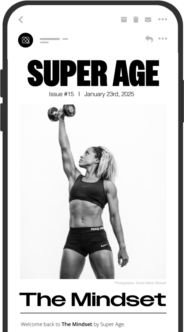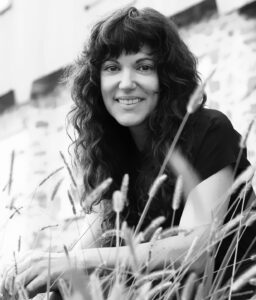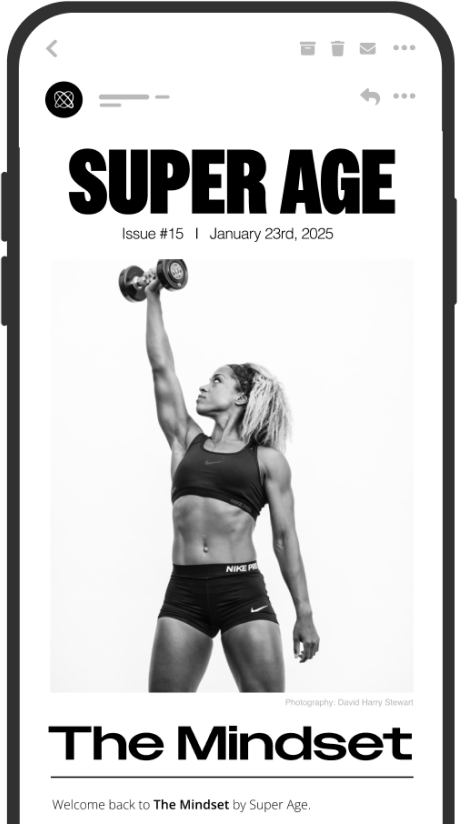7 Game-Changing Takeaways from the NYT Well Festival

A warm breeze was blowing through the open doors of the Duggal Greenhouse in Brooklyn, and the room was full of energy and talk of meditation.
Nearly every speaker at the New York Times Well Festival this year mentioned some kind of mindfulness or contemplative practice. But this wasn’t your average wellness conference. It was vibrant, vulnerable, and grounded in science.
Here’s what stood out and what you can take home and actually do to live longer, healthier, and more connected.
1. Mindfulness Isn’t Optional Anymore
Mindfulness was the unsung headliner of the day. From Harvard psychiatrist Dr. Robert Waldinger, director of the world’s longest-running study on happiness, to NBA legend Dwyane Wade, absolute queen Tracee Ellis Ross, and Peloton powerhouse Robin Arzón, nearly every speaker at the NYT Well Festival touched on the power of presence.
Dan Harris, co-founder of the Happier meditation app, made sure to mention that meditation isn’t for everyone. But finding time to connect with the present moment doesn’t have to look like a traditional meditation. Charlamagne tha God kept it simple and powerful: “Take your shoes off. Walk in the grass.” That’s mindfulness, too. Arzón runs to quiet her inner critic. Writer Suleika Jaouad journals or paints. But everyone touted practicing presence as essential for reclaiming calm and clarity in the attention economy.
Try this:
- If you’re trying to sit in silent meditation and it’s not working, get up and move. Robin Arzón started running to quiet her harsh inner critic. What movement helps you listen better to yourself?
- Or take Charlamagne’s advice: walk outside barefoot. Connect with the earth. It’s an ancient form of nervous system regulation, and it’s free.
- Try a few meditation apps and see which one speaks to you. Or find your local Buddhist center because, as Dan Harris said: “Perhaps the most powerful way to learn is in person.”
2. Connection Literally Heals You
Dr. Waldinger’s 86-year Harvard study found something quietly revolutionary: the warmth of your relationships is more predictive of long-term health than your cholesterol levels. “We didn’t believe it at first,” he said, “but the science kept pointing to the same thing.”
It’s not just about having people in your life; it’s about intentionally nurturing those connections. In his words: “The people who were really the best at this were the people who actively reached out to other people, who regularly saw other people, regularly held other people in mind, and kept current with their lives. That is kind of a superpower that goes under the radar but when we looked at it in all of our research data, that was one of the most important predictors of who was going to feel good about their life.”
Try this:
- Do a “social fitness set” every week. Just like you’d schedule workouts, set a 15-minute block to check in with 1–2 people: send a text, a meme, a memory, or a quick “how are you, really?” message. Make it a weekly ritual.
- Create low-lift connection rituals. Waldinger and his wife have lunch together daily. What’s your version? It could be a Saturday coffee walk, a Sunday group text, or voice notes to your friends after dinner.
- Know your people. Keep a “connection list” of people who light you up but might slip through the cracks. Revisit it monthly and reach out intentionally.
- Say names. Make eye contact. Even casual interactions build a sense of belonging and resilience. Don’t underestimate the micro-moments.
Our relationships affect how we feel and how we function, right down to our biology. And if you want to live longer, being “socially fit” is just as essential as being physically fit.
3. Do Good, Feel Good. It’s That Simple
When we’re anxious, the instinct is often to turn inward in order to fix ourselves so we can feel better. But as Dan Harris reminded us, one of the most powerful ways to decrease your anxiety is to shift your focus outward. “Action absorbs anxiety,” he said. You don’t have to change the world. Just raise your “utility quotient. Be a little more useful in the world around you. Even small acts of service can pull you out of the swirl. Hold the door. Call your mom. Volunteer.
As Dacher Keltner noted, helping others activates the vagus nerve, releases oxytocin, and calms the threat response in the brain. In other words: compassion isn’t just kind; it’s regulating. Altruism is self-care.
Try this:
- Pick one small act of service you can do today—text someone who’s struggling, help a neighbor, compliment a stranger. “Volunteer at a food pantry or an animal shelter, call your mom, be there for friends who are suffering, write a song for them,” suggested Harris.
- Notice how it makes you feel. Helping others boosts oxytocin, soothes stress hormones, and strengthens your own resilience. Plus, it connects you more directly to the world around you. And a lot of our anxiety is rooted in disconnection.
4. Don’t Chase Motivation. Create Momentum
Peloton’s head instructor and VP of fitness programming Robin Arzón’s message? “Motivation is fleeting. It’s ephemeral,” she says. Momentum is the name of the game. “It’s habit. It’s process. It’s schedule,” says Arzón. “Consistency is the real flex. Treat your movement practices like they’re a meeting with an important client you can’t miss.” Because they are! You!
Dwayne Wade said something similar about his morning fitness routine, which includes meditation and yoga. “I get up at five, six in the morning, and I’m selfish for at least two hours before my family wakes up.”
Try this:
- Put your workout on your calendar like a meeting with your most important client: you. Show up. No excuses.
- Don’t wait to feel ready. Begin anyway. Two minutes of motion can flip your mindset and build momentum.
- Pick a movement that makes you feel strong, not small. Run, lift, dance, hike, stretch, swim. The magic is in the showing up, not the modality.
Power isn’t a personality trait. It’s a practice. And every rep, every step, every session is a vote for the version of you that feels most alive.
5. Peter Attia’s Three Non-Negotiable Longevity Tests
Longevity expert Dr. Peter Attia didn’t mince words at Well Fest: The current standard of health care is not built for “medicine 3.0.” Most of today’s recommendations are reactive, not preventative. If you want to extend your healthspan (not just lifespan), you need to be more proactive and that starts with better testing.
Here are three labs Attia considers non-negotiable for anyone serious about longevity:
- ApoB: A more accurate predictor of cardiovascular risk than LDL cholesterol. ApoB counts the actual number of particles that can form plaque in your arteries and it turns out that number matters more than how much cholesterol is in each particle. “The United States is the only OECD country that hasn’t figured out the benefit of APOB in its complete and utter superiority over LDL cholesterol,” says Attia
- Lipoprotein(a), or Lp(a): A highly genetic marker of heart disease that isn’t screened for in most annual physicals. This “silent risk factor” can significantly increase your heart disease risk even if everything else looks normal.
- Oral Glucose Tolerance Test (OGTT): Attia says this is far more accurate than the hemoglobin A1C, which is often used to diagnose diabetes but can miss early signs of dysfunction. The OGTT measures how your body handles sugar over a two-hour window, revealing issues like insulin resistance long before full-blown diabetes shows up.
These are the kinds of metrics that can change the course of your health 20 years before symptoms arrive. You don’t need a concierge doctor to take charge of your health. You just need the right questions, the confidence to ask them, and a doctor willing to hear them.
Try this:
- Print this list and bring it to your next check-up: Ask your doctor to test for ApoB and Lp(a). They may not be in your standard panel, but most providers can order them.
- If you’re unclear about your blood sugar trends, request an OGTT, especially if you’ve ever been told your A1C is “borderline.”
6. Train for the Final Decade
Attia then introduced one of the most powerful reframes at Well Fest: train for your final decade. He calls it the Marginal Decade, the final 10 years of your life, when physical decline accelerates and small limitations can become life-altering. And he shared a hard truth: “Everybody is going to have a final decade.” Most people don’t recognize they’ve entered that final decade until it’s too late to change the outcome. That’s why Attia argues that we need to start training now for the physical tasks we want to preserve decades from today.
He calls this the Centenarian Decathlon, “Which is neither a decathlon nor exclusively for centenarians,” he said. The way it works is you pick the 10 most important and hardest things you want to be able to do, and you start training for them now.
Attia’s own list includes driving a race car in his 80s, shooting a bow and arrow, sitting on the floor with children and standing back up without assistance, and walking confidently on uneven terrain. Sounds simple now, right? But these basic movements require strength, stability, coordination, and mobility, systems that decline sharply without resistance training, balance practice, and targeted movement.
Try this:
- Write your own Centenarian Decathlon. What 10 physical actions matter most to you in old age? Be specific and personal.
- Assess where you are today. Can you get up from the floor unassisted? Do you struggle with balance or lifting heavy bags? That’s your training roadmap.
- Rebuild backward. If you want to be able to dance at 88, start strength training, balance work, and foot stability exercises now.
- Schedule it. Treat your future independence like a project. Calendar your workouts. Measure progress. Don’t leave it to chance.
Attia’s message is clear: Training for longevity isn’t about aesthetics. It’s about autonomy. Do the work now so you can live fully later on your own terms.
7. Practice the Art of Creative Adaptation
Suleika Jaouad shared that her creative journey didn’t begin from inspiration—it began from isolation. Diagnosed with leukemia at 22 and confined to a hospital room, she turned to journaling as a daily lifeline. “No part of me felt inspired or creatively motivated… I was scared. I was angry. I felt profoundly stuck and isolated,” she said.
What started as a small act to bring light into a dark moment became a transformational 100-day creative practice. Later, during a recurrence of her illness, when her vision was impaired, she didn’t abandon the ritual; she pivoted. She painted her hallucinations and dreams in watercolor, describing it as a form of “creative alchemy.” Her story is a lesson in nimbleness. In the face of uncertainty, it’s not about performing resilience but about surrendering to the process. It’s about staying flexible, playful, and curious enough to alchemize disruption into something meaningful, even beautiful.
Try this:
- Start a 10-day creative practice. Choose something simple: journaling, doodling, collage, sound recording. It doesn’t have to be perfect; it just has to be honest.
- Try Jaouad’s “10 Images” prompt: Take a moment to write about 10 moments from the past 24 hours. They can be tiny. They can be pictures, collages, voice memos. The goal is to notice more than perfect.
- If life feels like it’s falling apart, ask: What might I create with this? Not in spite of it, but through it?
Jaouad reminds us that you don’t have to be the mountaintop sage. You just have to show up, get curious and scrappy, and be willing to play with what the moment gives you.
Joy Is the Gateway
The biggest theme of the day? Movement, presence, and connection aren’t just wellness buzzwords. They’re daily portals to joy, purpose, and vitality. And they’re available to everyone. You just have to choose to start.
The information provided in this article is for educational and informational purposes only and is not intended as health or medical advice. Do not use this information to diagnose or treat any health condition. Always consult a qualified healthcare provider regarding any questions you may have about a medical condition or health objectives. Read our disclaimers.
The number of years you live in good health, free from chronic illness or disability.
Learn MoreLiving a long life; influenced by genetics, environment, and lifestyle.
Learn MoreThe practice of paying attention to the present moment with non-judgmental awareness.
Learn MoreThe ability to move freely and easily through a full range of motion.
Learn More


